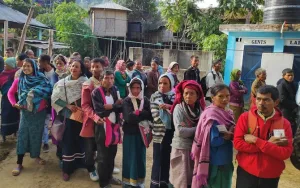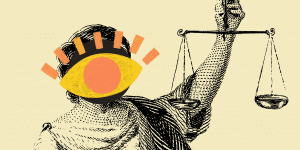Haryana’s Women Carve a Larger Role in The State’s Politics

In Haryana, a state with a skewed sex ratio (913 girls to 1000 boys, an improvement from 830 girls in 2011), there is one gender indicator has been on a rise- women’s political representation. 14% of Members of Legislative Assembly (MLAs) in Haryana’s just dissolved legislature were women- the highest in India along with West Bengal and Chhattisgarh. 31% of women MLAs were from the Scheduled Castes. The number of women contestants in Haryana’s Vidhan Sabha elections has risen by 136% between 2000-2014. Women candidates from the Scheduled castes has increased by 158% in the same period.
As Haryana goes to polls to elect a new Vidhan Sabha (Legislative Assembly) on 21st October, BehanBox analyses data across the years to construct the history of women’s political participation in the state.
Haryana- One among only 8 Vidhan Sabhas with more than 10% women MLAs
The dismal state of women’s representation in India’s Vidhan Sabhas is evident from the fact that only 8 of 29 state legislatures have more than 10% women MLAs, far short of a minimum 33% that women in India have been advocating for. Haryana with 14% women MLAs is the highest among them.
[Image description: Horizontal bar chart ranking states based on the percentage of women MLAs in Vidhan Sabhas. Chattisgarh, Haryana, West Bengal-14%, Puducherry-13%, Rajasthan, Bihar-12%,UP-11%, Jharkhand-10%, Sikkim, Tamil Nadu, Madhya Pradesh, Odisha, Delhi-9%, Andhra Pradesh-8%, Gujarat, Uttarakhand, Maharashtra-7%, Assam, Arunachal Pradesh, Himachal Pradesh-6%]
Haryana elected the highest number of women MLAs in the state’s electoral history in 2014, when 13 women found a place in the Vidhan Sabha. However, the history of women’s representation has followed an undulating path in Haryana.
Between the first two elections in 1967 and 1968, the proportion of women MLAs jumped from 5% to 9%, thereafter decreasing consistently. 2005 was the tipping point for women’s representation when, for the first time in the state’s history, women MLAs constituted 12% of the total strength. 11 women were elected in 2005- a massive jump from 4 in the previous term in 2000.
[Image Description: Vertical stacked bar chart showing the proportion of women MLAs in Haryana Vidhan Sabha over the years. 1967-5%, 1968-9%, 1972-5%,1977-5% 1982-4%,1987-8%, 1991-6%, 1991-7%, 1996-4%,2000-4%, 2005-12%,2009-10%,2014-14%]
[ Image Description: A stacked bar chart showing partywise women MLAs across the years in Haryana Vidhan Sabha]
Women Contestants in Haryana Increase by 112% in Two Decades
Women contestants in Haryana’s state assembly elections have seen a steady rise from the first elections in 1967 by 112%, except in 2000 when the number of contestants dropped to 49 from 93 in the previous elections. In the upcoming elections, once again, the number of women contesting has dropped to 106 from 116 in the last elections in 2014.
While the number of women contestants has increased (except on 2 occasions), the proportion of women elected to the Vidhan Sabha has fallen.
In the first elections 50% of the women who contested won, followed by 58% in the next elections in 1968. In 2014, only 11% of women who contested were elected.
[ Image Description: A line chart showing the number of women contestants over the years in Haryana Vidhan Sabha.
1967-8, 1968-12, 1972-12,1977-20 1982-27,1987-36, 1991-41, 1996-93, 2000-49,2005-60, 2009-69,2009-69,2014-116]
Main Political Parties Have Reduced the Number of Tickets To Women
Two main political parties- Bharatiya Janata Party( BJP) and Indian National Lok Dal (INLD) gave fewer tickets to women in the upcoming elections, according to an analysis by Association of Democratic Reforms, an NGO tracking elections in India. While the BJP which gave 15 tickets to women in 2014 has only given tickets to 12 women, INLD has allocated 15 tickets as opposed to 16 in 2014. Yet, INLD has allocated 23% tickets to women among their total contestants-the highest proportion among all the parties. The BJP has given 16% and Indian National Congress 13% tickets to women. The Aam Aadmi Party (AAP) which is contesting for the first time in Haryana has allocated 21% tickets to women.
[ Image Description: A line chart showing the number of women contestants from different parties over the years in Haryana Vidhan Sabha.]
Independent women candidates in Haryana have have an interesting story. Between 1991 and 1996, they increased from 24 to 62 and dropped to a mere 15 women contestants in the very next elections in 2000. Since then, they have been largely constant.
[ Image Description: A line chart showing the number of independent women candidates from different parties over the years in Haryana Vidhan Sabha. 1967-2, 1968-3, 1972-2,1977-8, 1982-18,1987-24, 1991-24, 1996-62, 2000-15,2005-22, 2009-20,2009-33,2014-23]
More Scheduled caste women now contesting elections and winning in Haryana
The last elections in 2014, saw the most number of women from the Scheduled Castes (SC) contest in the electoral history of Haraya. 31 SC women- 27% of the total women contestants- fought elections in 2014, a massive increase from 10 in 2009.
[ Image Description: A line chart showing the number of independent women candidates from different parties over the years in Haryana Vidhan Sabha. 1967-2, 1968-1, 1972-4,1977-3, 1982-3,1987-6, 1991-8, 1996-22, 2000-12,2005-14, 2009-10,2014-31]
As a consequence, 31% of SC women were elected to the Vidhan Sabha in 2014. However, it is not the highest proportion in the state’s history. In 1991, half of the women elected to Vidhan Sabha were from the Scheduled Castes.
[ Image Description: A line chart showing the number of independent women candidates from different parties over the years in Haryana Vidhan Sabha. 1967-0, 1968-14%, 1972-0,1977-25%, 1982-14%,1987-20%, 1991-50%, 1996-25%, 2000-25%,2005-45%, 2009-22%,,2014-31%]
We believe everyone deserves equal access to accurate news. Support from our readers enables us to keep our journalism open and free for everyone, all over the world.




